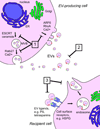Extracellular vesicles: emerging targets for cancer therapy
- PMID: 24703619
- PMCID: PMC4082760
- DOI: 10.1016/j.molmed.2014.03.002
Extracellular vesicles: emerging targets for cancer therapy
Abstract
Extracellular vesicles (EVs), including exosomes, microvesicles, and apoptotic bodies, are released by almost all cell types, including tumour cells. Through transfer of their molecular contents, EVs are capable of altering the function of recipient cells. Increasing evidence suggests a key role for EV mediated intercellular communication in a variety of cellular processes involved in tumour development and progression, including immune suppression, angiogenesis, and metastasis. Aspects of EV biogenesis or function are therefore increasingly being considered as targets for anticancer therapy. Here, we summarise the current knowledge on the contributions of EVs to cancer pathogenesis and discuss novel therapeutic strategies to target EVs to prevent tumour growth and spread.
Keywords: cancer therapy; exosomes; extracellular vesicles; metastasis; microvesicles; tumour microenvironment.
Copyright © 2014 Elsevier Ltd. All rights reserved.
Conflict of interest statement
MJW has filed patent applications in relation to extracellular vesicles: WO2010/119256, priority date April 2009; UK1121070.5 and UK1121069.7, filed December 2011. XOB is on the Scientific Advisory Board of Exosome Diagnostics, Inc.
Figures



References
-
- Thery C, et al. Membrane vesicles as conveyors of immune responses. Nat Rev Immunol. 2009;9:581–593. - PubMed
-
- van der Pol E, et al. Classification, functions, and clinical relevance of extracellular vesicles. Pharmacol Rev. 2012;64:676–705. - PubMed
-
- El Andaloussi S, et al. Extracellular vesicles: biology and emerging therapeutic opportunities. Nat Rev Drug Discov. 2013;12:347–357. - PubMed
Publication types
MeSH terms
Substances
Grants and funding
LinkOut - more resources
Full Text Sources
Other Literature Sources

